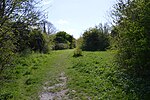Wheathampstead Local Nature Reserve
City of St AlbansLocal Nature Reserves in Hertfordshire

Wheathampstead Local Nature Reserve is a 5.9 hectare Local Nature Reserve (LNR) in Wheathampstead in Hertfordshire. It was declared an LNR by St Albans City Council in 2002, and is leased by Wheathampstead Parish Council from Hertfordshire County Council.The L shaped site borders football pitches. There is ash woodland, thorn scrub and mature hedgerows, together with an area of rough grassland. There are birds such as grass vetchling and bee orchid, birds including yellowhammer and whitethroat, and many butterflies.There is access from the Wheathampstead Development Centre and by a gate on the B651 south of Butterfield Road.
Excerpt from the Wikipedia article Wheathampstead Local Nature Reserve (License: CC BY-SA 3.0, Authors, Images).Wheathampstead Local Nature Reserve
Little Rivers, Welwyn Hatfield Panshanger
Geographical coordinates (GPS) Address Nearby Places Show on map
Geographical coordinates (GPS)
| Latitude | Longitude |
|---|---|
| N 51.8042 ° | E -0.18188 ° |
Address
Little Rivers 6-9
AL7 1QJ Welwyn Hatfield, Panshanger
England, United Kingdom
Open on Google Maps






